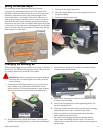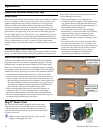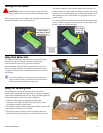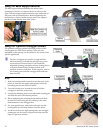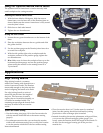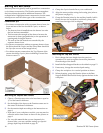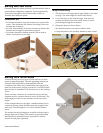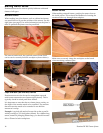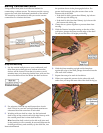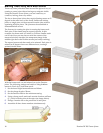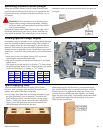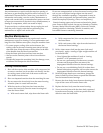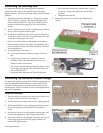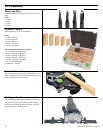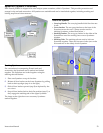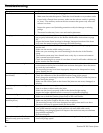
24 Domino DF 500 Tenon Joiner
Troubleshooting
Symptom Possible Causes
Motor does not start
1. Check that the cord is properly plugged into an outlet.
2. Make sure the outlet has power. Check the circuit breaker or try another outlet.
3. If used with a Festool dust extractor, make sure the selector switch is pointing
to "Auto". The auxiliary outlet on the dust extractor has power only when the
selector is at Auto.
4. Inspect the power cord (including extension cords) for damage or missing
prongs.
5. The motor brushes may have worn and need replacement.
Plunging action is not smooth ► Clean the linear rails and bronze bearings of the plunge slide, and make sure they
are properly lubricated (refer to the Routine Maintenance instructions on page
20).
► Inspect the bronze linear bearings for damage. Improper insertion of the fence
body onto the motor housing can damage the linear bearings.
Domino tenons are too loose ► Make sure you hold the Domino joiner firmly in position while plunging the
mortise slot.
► Make sure the mortise width setting is correct.
► Make sure you are using the correct mortising bit for the size of the Domino
tenon.
► The Domino tenons may have shrunk in an overly dry or warm environment.
This is normal wood movement.
► Check the mortising bit to ensure it is not bent. A bent bit will make a thicker and
wider mortise slot than desired.
Domino tenons are too tight ► The most common cause for this is that the tenons are stored in a humid
environment, and they have swelled from moisture absorption. Store the tenons
in a cool dry environment.
► The mortising bit may have been improperly sharpened or sharpened too many
times. Replace the bit.
Workpiece joints are misaligned
horizontally
► Check the calibration of the locating pins.
► Check the calibration of the Horizontal Position Gauge (sight gauge).
► Don’t plunge the mortising bit into the work too fast. This may cause the joiner to
move during the plunge.
► Make sure the friction pads on the front of the joiner are not worn, damaged, or
missing.
Workpiece joints are misaligned
vertically
► If the mortise slots were registered from the bottom of the baseplate, make sure
there is no dust or debris under the joiner.
► Make sure the fence is properly locked at the desired height setting.
► Inspect the height adjustment lock to ensure it is not broken (slipping).
Tilted or misaligned mortise slots ► Make sure the fence is set to the correct angle (e.g. 90 degrees).
► Make sure to hold the Domino joiner firmly to the work surface.
Workpiece joint won’t close (gaps
between pieces)
► Make sure the proper plunge depth is set.
► Make sure the joiner is tight to the face of the workpiece.
► The mortising bit may have been sharpened too many times and is too short.
► Excessive dust may be present inside the linear slide.
Tearout or rough mortise slots ► Plunging speed too fast. Slow down the rate of your plunge.
► Low-grade materials and plywoods will tear out more than solid woods.
Decreasing your plunging speed will improve the results but may not eliminate
the problem completely.
► Dull mortising bit.
Tapered mortise slot. The Domino
tenon fits only part way into the
slot
► The plunge speed is too fast and the bit is not cutting the sides properly. Slow
down the plunge speed.



